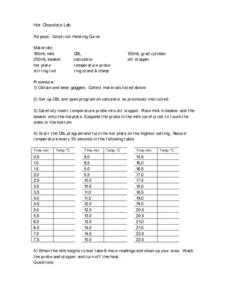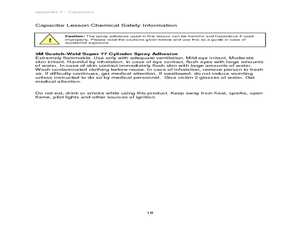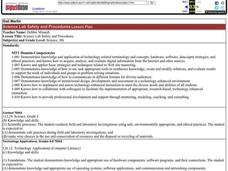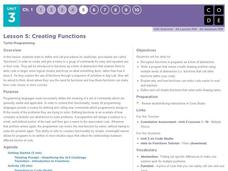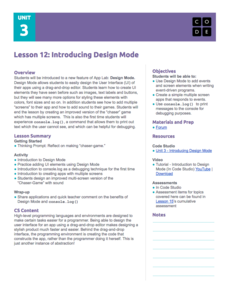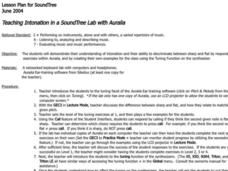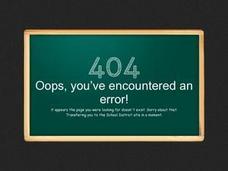Curated OER
Computer Software and ACS Materials for Chemistry
Students use computer software to simulate chemistry laboratory experiments. In this experimenting using computer software lesson plan, students use software called "The One Computer Classroom" to investigate wave simulations as a whole...
Curated OER
Documenting and Removing Network Protocols
In this technology worksheet, students practice using and setting up computer networks specifically through removing older protocols.
Curated OER
Working With Start Up Options
In this technology worksheet, students practice the process of starting up the network and individual computers while using the skill of troubleshooting.
Curated OER
Worksheet 7 Computer Lab
In this math worksheet, students program the computer to display a direction field plot for an equation. They plot several solutions on a graph.
Curated OER
Recipes for Foreign Foods
Upper graders choose a foreign country to research. They use the computer to locate three recipes from the country of their choice. Next, they link the information in each recipe to what they know about nutrition and food. Note: This...
Curated OER
Communication Technology
While working in groups, learners refine the negative prints, floppy disks, and photographs they've been working on. They rotate to different stations on paper cutting, airbrushing, and computers. Special attention is placed on the...
Curated OER
Hot Chocolate Lab
Students wear goggles and collect materials and then set up computer program to use the temperature probes. They insert the probe into the milk recording temperature every 30 seconds and then record the data on the table.
Chicago Botanic Garden
Leaf Litter Ecology Lab
Some organisms spend their entire lives in leaf litter. The third in a series of six is a great instructional activity exploring the community of leaf litter. Groups gather and then spread leaf litter over white paper and remove...
Curated OER
Capacitors: What Are They?
Students discover how capacitors help store data. In this computer science lesson, students investigate how capacitors can store an electronic charge, eventually helping computers store data. Students create their own...
Curated OER
An Introduction to Computer Components
Students experience the first lesson in computer servicing by observing computer components. They observe the internal workings of a computer during the lecture section of the lesson before dismantling a computer to identify its major...
Curated OER
Science Lab Safety Procedures
Eighth graders watch a Lab Safety video and discuss particular questions related to lab safety. Lab equipment is then distributed and the students inspect the equipment and record their finding in their journal. Finally, in groups, 8th...
Code.org
APIs and Using Functions with Parameters
Introduce your class to the API, a reference guide that lists and explains the functionality of programming language. Using JavaScript, individuals draw complex designs that require additional commands and parameters defined in the...
Code.org
Creating Functions
Quit repeating yourself ... you can make this simpler! Rather than repeating the same set of code over and over, class members learn to build and call functions in a series of challenges in App Lab. In the end, they combine...
Code.org
Introduction to Arrays
How can you store lists in a computer program? The 16th installment of a 21-part unit introduces arrays as a way to store lists within a variable. Individuals program a list of their favorite things—adding interest to the activity.
Code.org
Looping and Simulation
Young computer scientists continue programming with while loops by creating a program to simulate coins flipping.
Code.org
Introduction to Digital Assistant Project
How does a computer recognize voice commands? Scholars learn about digital assistants and natural language processing (NLP) algorithms in the ninth instructional activity of the series. They begin building a simple digital assistant and...
Code.org
Introducing Design Mode
Move beyond buttons when designing user interfaces. In the fourth installment of a 21-part unit, young computer scientists learn to apply design mode, which gives users options for colors, fonts, etc. They learn to incorporate these...
Code.org
User Input and Strings
Pupils learn to apply strings in computer science. They master two new user interface elements and also use string type data to represent ASCII characters. Finally, individuals create an app for Mad Libs in the eighth lesson of the series.
Code.org
Events Unplugged
Introduce event-driven programming. Young computer scientists learn the meaning of event-driven programming and how it is different from previous styles of programming. They play a card game to simulate the challenges that occur in this...
Curated OER
Teaching Intonation in a SoundTree Lab with Auralia
Learners demonstrate intonation and their ability to discriminate between sharp and flat by responding to exercises within Auralia, and by creating their own examples for the class using the Tuning Function on the synthesizer. Requires a...
Curated OER
Density Lab
Students find the density of two substances. In this density lesson plan, students determine the density of water and ethyl alcohol and compare their densities. They enter their data into the computer to produce a class compiled graph....
Curated OER
pH Lab
For this pH worksheet, young scholars experiment with dilutions of acidic solutions to test for the pH using cabbage as an indicator. They then test a variety of substances for pH. On day two of the lab, they test conductivity of...
LABScI
Harmonic Motion: Pendulum Lab
Several times throughout history, groups of soldiers marching in rhythm across a suspension bridge have caused it to collapse. Scholars experiment with pendulums, resonance, and force to determine why this would happen. First, pupils...
Curated OER
Video Reporters - "Get Ready to Use Your Computer"
Students use technology to produce a student-produced video that shows other students how to adjust keyboard, monitor, chair, and posture for safe and healthy usage of computer. It also demonstrates how to ask for help appropriately in...








